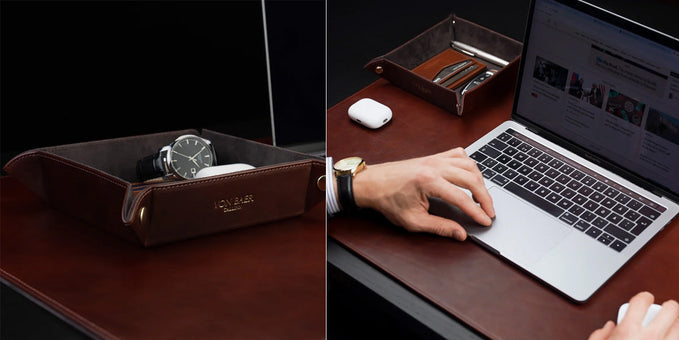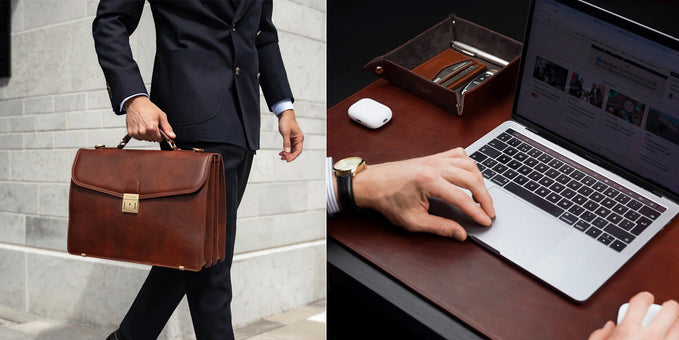Bonded Leather

Looking for a leather bag or leather furniture might be complicated because of the many kinds of leather.
Faux leathers, combined faux and real leathers, and genuine leathers are all available.
Clothing and furnishings are two common things made from bonded leather.
Yet, is bonded leather faux or real?
What is bonded leather exactly?
Read on to find out.
What is bonded leather?
Bonded leather is a blend of real and faux leather. It is made of genuine leather processing waste and fibers combined with a polyurethane binder.
Then, to attach these fibers to a paper background, they are rolled together using adhesives. Some producers may emboss the bonded leather and apply an additional polyurethane coating to give it a genuine leather-like texture.
Only 10–20% of bonded leather is made from genuine leather. While only having a small amount of genuine leather, some producers sell bonded leather as real leather.
Several other names are also used to refer to bonded leather. Look for the following things on the tag of your apparel or furniture:
- Faux Leather
- Vinyl
- Bonded Leather
- Composite
- LeatherSoft
- Reconstituted
What Distinguishes Bonded Leather from Real Leather?
Furniture, car seats, other products, and many other items all use bonded leather more and more frequently. Ten to 20% of bonded leather, commonly known as faux or composite leather, is made of genuine leather. Real leather scraps are combined to create composite leather attached to a paper backing.
Leather fragments are combined to create a polyurethane binding agent that resembles the texture of genuine leather skin more. Because they are readily available and reasonably priced, fake leather materials are becoming increasingly popular. Also, the production of bonded leather uses material that would have otherwise been discarded.
If you want a better quality product, you should choose one made from "full-grain leather," as it's more durable and looks better. At Vonbaer.com, we choose to use full-grain leather in all of our bags.
Related:
- Leather
- Faux leather
- Vegan leather
- Faux leather vs real leather
- Genuine leather
- Pleather
- Top grain leather
- Leather types
- Leather guide for beginners
- What is leather patina
- Vegetable tanned leather
- Leather tanning
- What is artificial leather?
- What is full grain leather

Bonded Leather: Pros & Cons
It is advisable to weigh the benefits and drawbacks of bonded leather before deciding so that you are aware of what to anticipate when receiving your furniture or apparel.
Pros:
- Unlike genuine leather, which has flaws in its overall appearance, bonded leather has a smooth, consistent texture.
- Bonded leather is not as expensive as genuine leather because it contains less than 20% real leather.
- Bonded leather smells more like genuine leather than synthetic leather.
- You can get bonded leather in various styles and colors.
Cons:
- Sunlight can cause the color to fade.
- Unlike real leather, bonded leather degrades over time and is readily scratched, peeled, and flaked.
- Bonded leather has a short lifespan and is not as robust as real leather.
- The item is not vegan. Go for 100% PU Leather if you seek a vegan leather substitute.
- Cleaning bonded leather can be challenging. Certain cleaning agents can be harsh and gradually strip the leather away.
- Bonded leather has the potential to leak some of the chemicals that were used to join the fibers together over time.
How to Recognize Bonded Leather
Many people mistake bonded leather for real leather, and producers occasionally label bonded leather as such. While looking for furniture, knowing the difference between bonded leather and genuine leather will be useful.
The price is the primary distinction between bonded leather and real leather. Because bonded leather is not created from actual leather, it will be substantially less expensive. Genuine leather will always be costlier than imitation leather.
Bonded leather can feel synthetic and will likely be thinner than genuine leather.
Although bonded leather occasionally has a similar feel and fragrance to genuine leather, its appearance differs. While natural leather will have certain flaws, bonded leather will have a consistent texture.
Related:
- Repair cat scratches on leather
- Remove water stains from leather
- Clean leather wallet & remove stains/smells
- Remove ink from leather
- Get smell out of leather
- Remove stains from leather shoes
- Clean suede leather bag
- How to reform a leather bag
- How to maintain leather bags
- Repair cracked leather
- Wet leather
- How to clean leather bag
- How to restore faded leather bag
What Industries Use Bonded Leather?
Bookbinding, furniture, and several fashion accessories sectors use bonded leather. Cases, book covers, and covers for personal gadgets, shoe components, accessory linings, briefcases, portfolios, belts, chairs, handbags, and couches are a few items that are frequently made using various types of bonded leather.
Books like Bibles and diaries are frequently covered in a more delicate paper-backed bonded leather, as are different desk accessories. These bonded leathers may have less leather than those used in the furniture business, but some leather is still exposed on the surface, giving off the distinctive leather smell.
Artificial leather that looks like bonded leather can also be used for these same uses.
Care Instructions for Bonded Leather
The best way to maintain your bonded leather is as follows:
- Be careful not to damage the surface of bonded leather by using harsh cleaning agents like bleach or ammonia.
- Keep bonded leather products out of the sun and heat sources to prevent fading or cracking over time.
- To preserve the appearance of bonded leather products and avoid drying out or cracking, consider using a professional leather cleaning and conditioner.
- Regularly dust-bonded leather products with a soft, dry cloth; when necessary, use a moist cloth to wash away dirt or stains gently.
- To prevent lasting damage to the material, avoid folding or creasing bonded leather products when not in use and store them in a cool, dry location.
- To ensure they won’t damage or discolor the bonded leather product, test any cleaning or conditioning chemicals on a tiny, discrete area first.
Related articles:
- Where does leather come from
- Mushroom leather
- Napa leather
- Pebbled leather
- Leather grades
- How is leather made
- Suede
- PU leather
- Bonded leather vs Faux leather
- Italian leather
- How to tell if leather is real
- Buffalo leather
- Suede vs Leather
- What is Real Leather
- Pu Leather vs Faux Leather
- Alternative Leather
- Chrome Tan Leather
Labeling
Bonded leather’s real leather content varies depending on the manufacturer and level of quality.
Using the phrase “bonded leather” to describe upholstery products, which are actually made of reconstituted leather, has generated some debate and controversy, especially in the home furnishings sector. A commenter from the Leather Research Laboratory referred to a product “Bonded leather is misleading since it masks the true nature of the material. It’s not leather; it’s either vinyl, polyurethane laminate, or a composite.”
To clear up any misunderstanding about bonded leather, the European Council for Standardization released EN 15987:2011 “Leather - Terminology - Essential definitions for the leather trade” in 2011. According to this standard, at least 50% of the product’s weight must be dry leather.
The US Federal Trade Commission advises including a portion of the leather. “The guidelines caution against misrepresenting the leather content in products containing ground, reconstituted, or bonded leather, and state that such products, when they appear to be made of leather, should be accompanied by a disclosure as to the percentage of leather or other fiber content,” according to the Federal Trade Commission.
The standards also require that any product advertising that may otherwise deceive consumers about the product’s composition should contain these disclaimers.
Conclusion
We hope you enjoyed our article on Bonded leather.
If you have any questions, leave them in the comments, or email Von Baer at info@vonbaer.com.
Browse related leather pages here.
Sources:
https://www.gov.uk/guidance/classifying-leather#leather
https://www.tariffnumber.com/2022/4115
https://books.google.co.uk/books?id=D-G3BQAAQBAJ&pg=PA12&redir_esc=y#v=onepage&q&f=false
https://en.wikipedia.org/wiki/Bonded_leather

Author: Albert Varkki
Albert Varkki is the co-founder of Von Baer. He understands leather products as a consumer, supplier, and a manufacturer, helping you with the inside knowledge you need, to choose the perfect leather product for you.
We strive for the highest editorial standards, and to only publish accurate information on our website.
Leave a Comment
Your email address will not be published.






